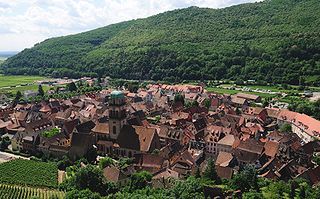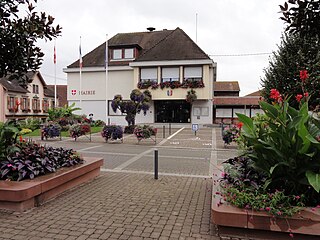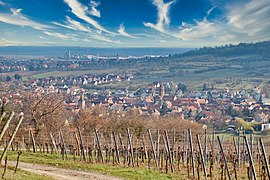
Alsace is a cultural region and a territorial collectivity in eastern France, on the west bank of the upper Rhine next to Germany and Switzerland. In January 2021, it had a population of 1,919,745. Alsatian culture is characterized by a blend of German and French influences.

Bas-Rhin is a département in Alsace which is a part of the Grand Est super-region of France. The name means 'Lower Rhine', referring to its lower altitude among the two French Rhine departments: it is downstream of the Haut-Rhin department. Both belong to the European Upper Rhine region. It is, with the Haut-Rhin, one of the two departments of the traditional Alsace region which until 1871, also included the area now known as the Territoire de Belfort. The more populous and densely populated of the pair, it had 1,152,662 inhabitants in 2021. The prefecture is based in Strasbourg. The INSEE and Post Code is 67.

Sélestat is a commune in the Grand Est region of France. An administrative division (sous-préfecture) of the Bas-Rhin department, the town lies on the Ill river, 17 kilometres (11 mi) from the Rhine and the German border. Sélestat is located between the largest communes of Alsace, Strasbourg and Mulhouse.

Haguenau is a commune in the Bas-Rhin department of France, of which it is a sub-prefecture.

Altorf is a commune in the Bas-Rhin department in the Grand Est region of northeastern France.

Kaysersberg is a historical town and former commune in Alsace in northeastern France. The name is German for Emperor's Mountain. The high fortress that dominates the town serves as a reminder of both its strategic importance and its warlike past.

Obernai is commune in the Bas-Rhin department in Alsace in north-eastern France. It lies on the eastern slopes of the Vosges mountains.

Marmoutier is a commune in the Bas-Rhin département in Grand Est in north-eastern France. The origin of the place is the former Marmoutier Abbey, of which the abbey church still serves as the parish church.

Andlau is a commune in the Bas-Rhin department in Alsace, Grand Est region of northeastern France.

Gottenhouse is a commune in the Bas-Rhin department in Grand Est in north-eastern France.

Avolsheim is a commune in the Bas-Rhin department in the Grand Est region of north-eastern France.

Rouffach is a commune in the Haut-Rhin department in Grand Est in north-eastern France.

Châtenois is a commune in the Bas-Rhin department in Alsace in north-eastern France.

Barr is a commune in the Bas-Rhin department in the Alsace region of north-eastern France.

Seltz is a commune in the Bas-Rhin department of the Grand Est region in north-eastern France. It is located on the Sauer River near its confluence with the Rhine, opposite the German town of Rastatt.

Hipsheim is a commune in the southeast of the Bas-Rhin department in Alsace in north-eastern France.

Hoffen is a commune in the Bas-Rhin department in Grand Est in north-eastern France.

Kuttolsheim is a commune in the Bas-Rhin department in Grand Est in north-eastern France.

Mommenheim is a commune in the Bas-Rhin department. The department is in the historic Alsace region of France, and is itself within the Grand Est administrative region of north-eastern France.

The history of the Jews in Alsace is one of the oldest in Europe. It was first attested to in 1165 by Benjamin of Tudela, who wrote about a "large number of learned men" in "Astransbourg"; and it is assumed that it dates back to around the year 1000. Although Jewish life in Alsace was often disrupted by outbreaks of pogroms, at least during the Middle Ages, and reined in by harsh restrictions on business and movement, it has had a continuous existence ever since it was first recorded. At its peak, in 1870, the Jewish community of Alsace numbered 35,000 people.



























